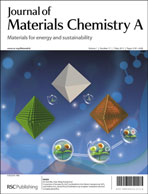Li0.3V2O5 with high lithium diffusion rate: a promising anode material for aqueous lithium-ion batteries with superior rate performance†
Abstract
Compared with non-aqueous lithium-ion batteries, aqueous lithium-ion batteries (ALIBs) have been widely regarded as a strategy to resolve the safety problems and reduce the manufacturing cost of lithium ion batteries. But the major challenge in ALIBs is the low capacity, especially at high current densities, due to the lack of suitable anode materials with high utilization efficiency of the theoretical capacity and fast lithium ion diffusion. Based on the calculation of Li+ diffusion coefficient (DLi+), Li0.3V2O5 is therefore first chosen as a novel anode material for ALIBs because of its rigid 3D tunnelled crystal structure with good electronic and ionic conductivity. When coupled with LiCoO2, its first discharge capacity is 182 mA h g−1 at a current density of 60 mA g−1 and remains at 112 mA h g−1 at a current density up to 180 mA g−1. These results are enabled by the facile ion diffusion and charge transfer during the process of charge–discharge at high rate, which is demonstrated sufficiently via the lithium insertion/


 Please wait while we load your content...
Please wait while we load your content...